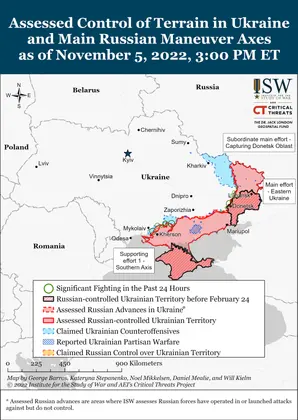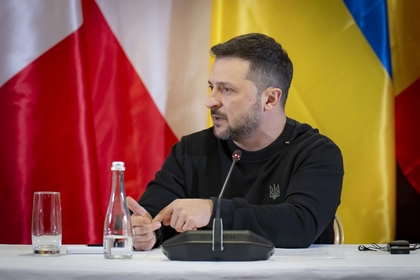Key Takeaways
- Wagner Group financier Yevheniy Prigozhin seeks to obfuscate his efforts to strengthen his independent power base with an appeal to the concept of Russia’s historic unity.
- Iranian Foreign Minister Hossein Amir-Abdollahian confirmed that Iran began providing Russia drones before February 24, but strangely denied that Russian forces have used them in combat.
- DNR military commander Aleksandr Khodakovsky claimed that Russian friendly fire may have caused up to 60% of total Russian losses since mid-May.
- Ukrainian troops reportedly continued counteroffensives along the Svatove-Kreminna line.
- Russian forces continued to set up defensive positions along the Dnipro River.
- Ukrainian forces continued to target Russian logistics and transportation in Kherson Oblast.
- Russian forces continued to attack around Bakhmut and claimed unspecified advances.
- Russian forces continued unsuccessful offensive operations in the Avdiivka-Donetsk City area and in western Donetsk.
- Continued poor conditions for mobilized soldiers catalyzed a large-scale protest in Kazan.
- Unknown actors reportedly attempted to assassinate high-profile Donetsk People’s Republic (DNR) Supreme Court Judge Aleksandr Nikulin.
- Russia continues to deploy personnel to staff administrative positions in occupied areas.
- Russian forces continued forced evacuations in Kherson Oblast. Over 80% of Kherson residents reportedly have evacuated.
Wagner Group financier Yevgeny Prigozhin seeks to obfuscate his efforts to strengthen his independent power base with an appeal to the concept of Russia’s historic unity. Prigozhin provided a vague response to a media inquiry regarding his recent visit to Kursk Oblast on Russia’s Unity Day (November 4), during which he had indirectly implied that Wagner forces are involved in upholding Russia’s unity.[1] Prigozhin stated that Russian people, businesses, government, and army need to come together to fight for Russia’s sovereignty and its great future while deflecting from the journalist’s question regarding Prigozhin’s reported meeting with Kursk businessmen about the organization of an unspecified people’s militia – outside of formal Russian military command structures. Prigozhin also noted that Russia has all the ingredients to achieve its goals including a strong president, cohesive army, and great nationhood, which he concluded with an out-of-place greeting from Wagner fighters. Prigozhin later claimed in a follow up media response that his “independence” does not contradict Russian President Vladimir Putin’s politics as some audiences have interpreted.[2]
JOIN US ON TELEGRAM
Follow our coverage of the war on the @Kyivpost_official.
Prigozhin’s rather sarcastic statements have several underlying implications for his perception of his power within Russia. ISW previously reported that Kursk Oblast officials announced the construction of second and third lines of defenses in the region, and if Prigozhin’s meeting with local businessmen took place, may indicate that he is attempting to expand his influence in the region.[3] Prigozhin’s comment on Russia’s “cohesive army” next to Putin was likely thinly-veiled sarcasm, given that Prigozhin has repeatedly criticized the Russian Armed Forces on numerous occasions.[4] Prigozhin also directly recognized that he is an independent entity, which as ISW previously assessed, relieves him of some obligations to the Kremlin and the Russian Ministry of Defense (MoD).[5] Putin’s dependency on Prigozhin’s forces around Bakhmut also allows Prigozhin privileges such as voicing his criticisms of the Kremlin or the Russian Armed Forces without significant ramifications. Prigozhin has also coincidentally opened his Wagner Center in St. Petersburg on Russia’s Unity Day.[6] However, Prigozhin is notably shielding his efforts to build an independent power base and shape the conduct of Russia’s invasion of Ukraine with language focused on Russian Unity – likely both to appeal to Russian nationalists and civilians and to deflect criticism of his fairly overt efforts to build an independent power base.

Russia Planned Genocide Long Before Invasion: Kill Lists, Crematoriums, Mass Graves – HUR
Prigozhin continues to rely on ineffective convicts to staff his forces. Prigozhin declined to comment on a reporter’s question regarding ongoing recruitment drives at Krasnoyarsk Krai penal colonies, despite previously openly discussing prisoner participation in the war with Russian outlets like RiaFan.[7] Russian opposition outlet The Insider, however, found that over 500 prisoners recruited into Wagner units have died in the past two months.[8] The publication added that Wagner lost between 800 and 1,000 mercenaries in Ukraine, indicating convicts comprise a large proportion of Wagner’s forces in Ukraine. Ukrainian intelligence officials also previously reported that many prisoners suffering from infectious diseases infected Wagner troops, to which Prigozhin responded that he does not discriminate on the basis of illness.[9]
Iranian Foreign Minister Hossein Amir-Abdollahian confirmed that Iran sent Russia combat drones. Amir-Abdollahian stated on November 5 that Iran “gave a limited number of drones to Russia months before” the war in Ukraine.[10] Amir-Abdollahian also claimed that if Ukrainian officials could prove that the Russian military has used Iranian-made drones in Ukraine then Iranian officials would “not be indifferent” to the concern – falsely and ridiculously implying that Russia has not used the drones that he admitted Iran has provided.[11] Iran’s confirmation of the drone shipments further supports ISW’s previous assessments that Russia is sourcing Iranian-made weapons systems to address the depletion of its high-precision munitions arsenal.[12] ISW previously assessed that Iran is likely already exploiting Russian reliance on these Iranian-made weapons systems to request Russian assistance with its nuclear program.[13] The nuclear assistance requests and the recognition of the drone shipments are both indicators that Iranian officials may intend to more clearly establish an explicit bilateral security relationship with Russia in which they are more equal partners.
Former Donetsk People’s Republic (DNR) Security Minister and current DNR military commander Aleksandr Khodakovsky claimed on November 5 that Russian friendly fire may have caused up to 60% of total Russian losses since the end of Russian offensive operations in Mariupol in mid-May.[14] Even if this statistic is exaggerated, the fact that a Russian commander is publicly speculating on such a damning indicator of Russian and proxy competency indicates the deep challenges Russian forces face. Friendly fire typically does account for a limited number of losses in war but ordinarily nowhere near 60% of total casualties, which demonstrates a lack of communication and command and control coordination between Russian forces. Russian and Ukrainian sources also reported that a Russian rotation returning to its base near Pavlivka, Donetsk Oblast on November 5 drove into a ditch constructed by army subcontractors without prior discussion or warning, further demonstrating a widespread lack of cross-training and coordination between Russian troops.[15] The frequent replacement of Russian military leaders, promotion of inexperienced soldiers, and cobbled-together Russian force composition including Russian contract soldiers, Russian mobilized soldiers, DNR and Luhansk People’s Republic (LNR) forces, and Wagner Group forces exacerbate the fragmented nature of the Russian chain of command and ineffectiveness of Russian forces and likely contributes to frequent friendly fire incidents.
See the full report here.
You can also highlight the text and press Ctrl + Enter






